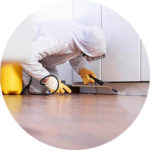By Hank Hirsch, B.C.E.
We can all agree that dealing with rodents, especially mice, can present some of the most challenging and frustrating pest situations in commercial facilities.
I have always said “a rodent infestation is a failed audit waiting to happen” since rodents present a significant food safety and human health risk. Commercial clients with a rodent issue are also subject to the following pitfalls:
- Damaged and spoiled product
- Regulatory issues – failed inspections and fines
- Lost production time
- Additional expenses for rodent remediation
- Damage to company’s brand
The RK Environmental approach to rodent management is founded in a systematic understanding and consideration of all control options including:
- Habitat modification
- Exclusion
- Sanitation to remove or minimize food sources
- Baiting and trapping
Denying rodent’s access to your facility is the best defense against an infestation and that is why RK Environmental is a strong proponent of exclusion. The pest management and food safety industry, as well as auditors and government inspectors, continue to trend toward ‘preventative controls’ and there is no question that the future of rodent management will revolve around rodent exclusion services.
The goal of rodent exclusion is to discourage rodent penetration. Since rodents have sharp teeth and instinctively gnaw, they can easily chew through or pick apart many different materials used for exclusion. Therefore, it’s critical that the right materials are used.
Some of the most common materials used for rodent exclusion in commercial facilities include:
- Sheet metal (galvanized, 24 gauge) is a perfect material. It’s too hard for rodents to chew through and can be used as a plate to keep rodents from scaling up into dock plates.
- Kick-plates made of 24 gauge galvanized metal are used on the base of pedestrian doors where heavy rodent pressure from rats can gnaw through the door base. Do not use aluminum as rodents can chew through it.
- Heavy duty hardware cloth is the preferred material for screening vents, open pipes or other openings. Metal window screening should be avoided since it’s simply not adequate and rodents can easily penetrate it.
- Door sweeps (made with stainless steel fibers) are a common option to deny rodents access to a structure. An optimal installation includes a door sweep on one side of the pedestrian door and a kick-plate, with less than a ¼ inch space on the other side.
- Overhead doors that have gaps at the base or unsealed dock plates are common entry points for rodents. Installing overhead door and dock plate seals will deny rodents access.
- Although cement may seem like a material that can’t be chewed/gnawed by rodents, we have seen repeatedly how rats have scratched and chewed through it. When using cement, it’s important that the cement is mixed with sand or even pulverized glass to prevent rodent penetration. Expandable foam is easy to use and can come in handy for quick exclusion projects.
- Wood can sometimes be used, but when there are exposed rough edges, rodents can be enticed to chew. Using a ‘smooth’ wood with beveled edges would be better to discourage chewing.
The RK Environmental team includes highly-trained, experienced rodent exclusion specialists who understand construction practices and know how to build rodents out.
For innovative solutions to your pest management issues and exceptional customer service, contact RK Environmental call 800.996.4402 or info@rkenvironmental.com
Hank Hirsch is a Board Certified Entomologist and president of RK Environmental Services and Comprehensive Food Safety














